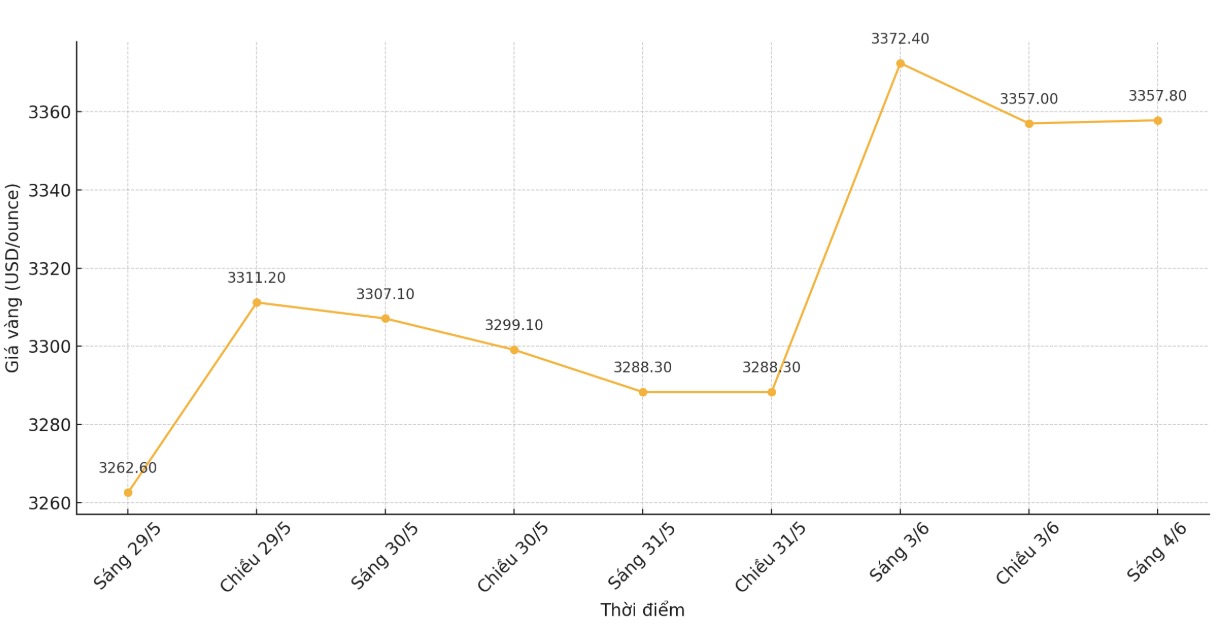The World Gold Council (WGC) report released on Tuesday showed that global central banks net bought 12 tonnes of gold in April - down 12% from the previous month and 28 tonnes lower than the 12-month average.
Mr. Krishan Gopaul, senior EMEA analyst at WGC, commented: "What could be behind the recent decline in monthly purchases? Partly because gold prices have increased rapidly since the beginning of this year.
Although continued increases to record highs are unlikely to stop central banks from buying gold, as they often have long-term strategies, this may partly explain the decline in monthly net buying.
This expert noted that the data fluctuates very strongly every month, so activities in one month do not necessarily reflect the following months. In addition, the data is sometimes delayed.
"Therefore, we recommend not to rush to conclusions from the recent stagnation. Although high prices may cause the proportion of gold in some reserve portfolios to reach near targets, we still expect the buying trend to continue, as the economic and geopolitical prospects are still uncertain, he said.

The Central Bank of Poland continues to lead
Poland continued to be the country with the most gold purchases in April, among the five countries that recorded a change of 1 ton or more.
In April, the Polish Central Bank (NBP) added 12 tons, bringing total reserves to 509 tons exceeding the European Central Banks level (507 tons). Since the beginning of the year, NBP has increased its reserves by 61 tons, equal to two-thirds of the plan of 90 tons in 2024, said Gopaul.
The Central Bank of the Czech Republic also increased 3 tons of gold in April. This is the 26th consecutive month that they have increased their gold reserves, with a total of 47 tons added. Total reserves reached nearly 59 tons by the end of April".
The People's Bank of China also continued to buy 2 tons of gold in April, marking the 6th consecutive month of buying. Since the beginning of the year, China has net purchased 15 tons, bringing its total reserves to 2,294 tons, Gopaul said.
The Central banks of Turkey and Kyrgyzstan also added 2 tonnes of gold each. Kazakhstan added 1 ton and Jordan added nearly 1 ton to its reserves.
In contrast, Uzbekistan sold 11 tons in April, the third consecutive month of similar sales. Since the beginning of the year, their gold reserves have fallen by 26 tons to 356 tons.
Since the beginning of the year, central banks have been buying gold widely, although it has mainly belonged to emerging markets, especially Poland, Gopaul noted. Meanwhile, the selling direction is less popular, but is also dominated by a single country.
The Reserve Bank of India (RBI) did not change gold prices in April, keeping it at 880 tons. However, in its latest semi-annual report, the RBI said 512 tonnes (58%) of total domestic gold reserves rose slightly in volume from six months ago (510 tonnes) but fell 60%. Two years ago, the rate was just 38%.
Many African central banks also join
Several central banks in Africa have announced plans to increase gold reserves in the near future.
In early May, the Namibia Bank announced a gold purchase plan to increase the gold reserve ratio to 3%, Gopaul said. The bank believes this is in line with the global trend, as gold has strategic value in preventing inflation and enhancing resilience to economic shocks.
According to the most recent IMF data from March 2019, Namibia has no gold reserves.
The Rwans Central Bank also announced that it is conducting research on including gold in its reserve portfolio. Governor Soraya Hakuziyaremye said:
Like other countries, we are considering the possibility of putting gold in reserves because of its ability to respond to financial market fluctuations and its role in preventing external risks.
It is known that gold purchases will start from the new fiscal year in July.
Central Bank of Uganda Governor Michael Atingi-Ego also said that they will diversify their reserves into gold purchased from domestic miners, to serve currency exchange maturities.
The Central Bank of Japan plans to buy 4 tons of gold to increase reserves and legalize exports. Meanwhile, the Governor of the Central Bank of Kenya said he is considering adding gold to reserves, but has not set a time.









